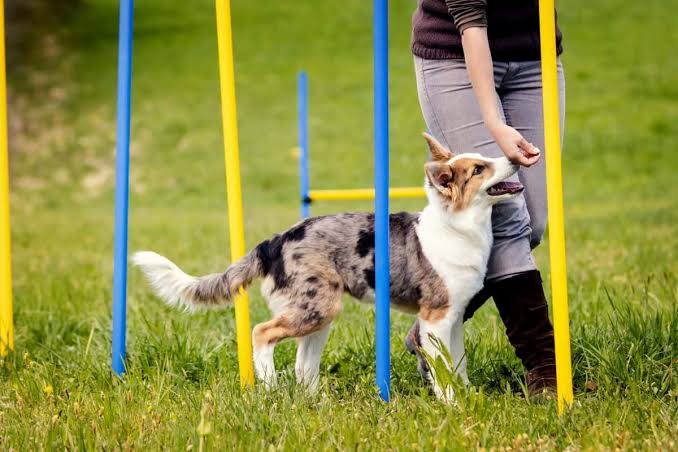
How to Train Your Dog: A Step-by-Step Guide for Beginners
Training your dog is essential for building a strong bond and ensuring good behavior. This step-by-step guide for beginners covers the basics of dog training, including positive reinforcement, essential commands, and troubleshooting common challenges. With patience, consistency, and the right techniques, you can teach your dog to be well-mannered, obedient, and a joy to have around.
🐶 Pet Star
14 min read · 13, Feb 2025

1. Understand the Basics of Dog Training
Before diving into training, it’s important to understand the principles that make it effective:
- Positive Reinforcement: Reward your dog for good behavior with treats, praise, or playtime. This encourages them to repeat the behavior.
- Consistency: Use the same commands and rewards every time to avoid confusing your dog.
- Patience: Training takes time, and every dog learns at their own pace. Stay calm and avoid punishment, which can create fear and hinder progress.
2. Gather the Right Tools
Having the right tools can make training easier and more effective. Here’s what you’ll need:
- Treats: Small, soft, and tasty treats are ideal for rewarding your dog.
- Leash and Collar/Harness: A standard leash and well-fitted collar or harness are essential for teaching commands like "heel" and "come."
- Clicker (Optional): A clicker can help mark desired behaviors with precision.
- Toys: Toys can be used as rewards and to keep your dog engaged during training sessions.
3. Start with Basic Commands
Begin with simple commands that form the foundation of good behavior. Here’s how to teach them:
Sit
- Hold a treat close to your dog’s nose.
- Slowly move the treat upward, causing their head to follow and their bottom to lower.
- Once they sit, say "Sit," give the treat, and offer praise.
- Repeat until your dog sits on command without the treat lure.
Stay
- Ask your dog to sit.
- Hold your palm out in front of their face and say "Stay."
- Take a step back. If they stay, reward them.
- Gradually increase the distance and duration.
Come
- Put your dog on a leash and let them wander a short distance.
- Say "Come" in a cheerful tone and gently pull the leash toward you.
- When they reach you, reward them with a treat and praise.
- Practice in a safe, enclosed area before trying off-leash.
Leave It
- Place a treat in your closed hand and let your dog sniff it.
- When they stop trying to get it, say "Leave it" and reward them with a different treat.
- Gradually practice with items on the ground.
Heel
- Start with your dog on a leash by your side.
- Hold a treat in your hand and say "Heel."
- Walk a few steps, rewarding your dog for staying by your side.
- Gradually increase the distance and reduce the frequency of treats.
4. Use Positive Reinforcement Effectively
Positive reinforcement is the cornerstone of successful dog training. Here’s how to use it effectively:
- Timing: Reward your dog immediately after they perform the desired behavior.
- Variety: Mix up treats, praise, and playtime to keep your dog motivated.
- Consistency: Always reward the same behavior to avoid confusion.
5. Keep Training Sessions Short and Fun
Dogs have short attention spans, so keep training sessions brief (5-10 minutes) and enjoyable. End on a positive note to keep your dog eager for the next session.
6. Socialize Your Dog
Socialization is a critical part of training. Expose your dog to different people, animals, and environments to help them become well-adjusted and confident. Start early and use positive reinforcement to create positive associations.
7. Address Common Training Challenges
Training isn’t always smooth sailing. Here’s how to tackle common issues:
- Jumping: Ignore your dog when they jump and reward them when they have all four paws on the ground.
- Barking: Identify the cause of barking (e.g., boredom or fear) and address it. Teach the "Quiet" command by rewarding silence.
- Pulling on the Leash: Stop walking when your dog pulls and only move forward when the leash is slack. Reward them for walking by your side.
8. Gradually Increase Difficulty
Once your dog masters basic commands, introduce more advanced training, such as:
- Tricks: Teach fun tricks like "roll over," "play dead," or "shake hands."
- Off-Leash Training: Practice commands in a safe, enclosed area before trying off-leash in open spaces.
- Distraction Training: Gradually introduce distractions to test and improve your dog’s focus.
9. Be Patient and Consistent
Training is a journey, not a race. Some dogs learn quickly, while others take more time. Stay patient, consistent, and positive throughout the process. Celebrate small victories and avoid getting frustrated.
10. Seek Professional Help if Needed
If you’re struggling with training or dealing with behavioral issues, consider consulting a professional dog trainer or behaviorist. They can provide personalized guidance and support.
Q1: What is the most important principle of dog training?
Ans) The most important principle is positive reinforcement, which involves rewarding good behavior to encourage your dog to repeat it.
Q2: How long should a training session be?
Ans) Training sessions should be short, around 5-10 minutes, to keep your dog engaged and prevent boredom.
Q3: How do I stop my dog from jumping on people?
Ans) Ignore your dog when they jump and reward them only when they have all four paws on the ground. Consistency is key.
Q4: Can I train an older dog?
Ans) Yes, older dogs can learn new commands and behaviors, although it may take more time and patience compared to training a puppy.
Q5: What should I do if my dog doesn’t respond to training?
Ans) If your dog isn’t responding, reassess your methods, ensure you’re using high-value rewards, and consider seeking help from a professional trainer.
Similar Articles
Find more relatable content in similar Articles
Explore Other Categories
© 2024 Copyrights by rPets. All Rights Reserved.